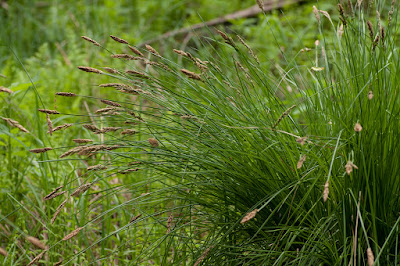
The Daru Mire of Kokad in the southernmost part of the Nyírség Region is a remnant of the postglacial period, when former river valleys were closed by sand dunes. It has many relict plants of cooler eras. It is located next to the wet meadows of the Mire of Álmosd and both are parts of the Kék Kálló Valley Natura 2000 area. Location: Mire of Kokad. Date: 09.05.2015.
Das Daru Moor von Kokad im südlichsten Teil der Nyírség Region ist ein Restbestand des postglazialen Zeitraum, in dem ehemalige Flusstäler von Sanddunen abgeschlossen wurden. Das Moor besitzt eine Pflanzenwelt mit vielen Kaltzeitrelikten. Es liegt neben den Feuchtwiesen des Moors von Álmosd und beide sind Anteile des Kék-Kálló Tal Natura 2000 Gebietes. Ort: Moor von Kokad. Datum: 09.05.2015.
A Kokadi Daru-láp a Nyírség legdélebbi részén a posztglaciális időszak maradványa, melyben az egykori folyómedreket homokdűnék zárták el. Növényvilága számos hidegkori reliktum miatt ismert. Az Álmosdi Daru-láp láprétjei mellett helyezkedik el, mindkettő a Kék-Kálló Völgye Natura 2000 terület része. Hely: Kokadi Daru-láp. Dátum: 2015.05.09.
A view of the mire:
Ein Blick auf das Moor:
A láp képe:

Marsh Ferns (Thelypteris palustris):
Sumpffarn (Thelypteris palustris):
Tőzegpáfrány (Thelypteris palustris):
Lady Fern (Athyrium filix-femina subsp. filix-femina):
Wald-Frauenfarn (Athyrium filix-femina subsp. filix-femina):
Hölgypáfrány (Athyrium filix-femina subsp. filix-femina):
Silverleaf Poplar (Populus alba):
Silber-Pappel (Populus alba):
Fehér nyár (Populus alba):
Common Nettle (Urtica dioica):
Große Brennnessel (Urtica dioica):
Nagy csalán (Urtica dioica):
A forget-me-not species (Myosotis sparsiflora):
Zerstreutblütiges Vergissmeinnicht (Myosotis sparsiflora):
Lazavirágú nefelejcs (Myosotis sparsiflora):
Fine-leaved Water-dropwort (Oenanthe aquatica):
Großer Wasserfenchel (Oenanthe aquatica):
Mételykóró (Oenanthe aquatica):
Common Comfrey (Symphytum officinale subsp. officinale):
Echter Beinwell (Symphytum officinale subsp. officinale):
Fekete nadálytő (Symphytum officinale subsp. officinale):
Drug Fumitory (Fumaria officinalis subsp. wirtgenii):
Gewöhnlicher Erdrauch (Fumaria officinalis subsp. wirtgenii):
Orvosi füstike (Fumaria officinalis subsp. wirtgenii):
Gewöhnlicher Erdrauch (Fumaria officinalis subsp. wirtgenii):
Orvosi füstike (Fumaria officinalis subsp. wirtgenii):
Common Marsh Bedstraw (Galium palustre):
Sumpf-Labkraut (Galium palustre):
Mocsári galaj (Galium palustre):
Black Alder (Alnus glutinosa subsp. glutinosa):
Schwarz-Erle (Alnus glutinosa subsp. glutinosa):
Enyves éger (Alnus glutinosa subsp. glutinosa):
Schwarz-Erle (Alnus glutinosa subsp. glutinosa):
Enyves éger (Alnus glutinosa subsp. glutinosa):
The Greater Tussock-sedge (Carex paniculata subsp. paniculata) is characteristic for its large tussocks:
Die Rispen-Segge (Carex paniculata subsp. paniculata) bildet sehr große Bulten:
A bugás sás (Carex paniculata subsp. paniculata) hatalmas zsombékjai miatt feltűnő:
Tussock Sedge (Carex elata subsp. elata):
Steife Segge (Carex elata subsp. elata):
Zsombéksás (Carex elata subsp. elata):
Hairs Sedge (Carex hirta):
Behaarte Segge (Carex hirta):
Borzas sás (Carex hirta):
A flat-faced longhorn beetle (Agapanthia violacea):
Agapanthia violacea Bockkäfer:
Kék bogáncscincér (Agapanthia violacea):

























No comments:
Post a Comment